Lillian Lee | |
|---|---|
 Lillian Lee, 1907 | |
| Born | ca. 1860 |
| Died | ca. 1941 |
| Occupation | Actress |
Lillian Lee was a stage actress in New York City beginning in the early 1880s. She was in the cast of the original Ziegfeld Follies in 1907. [1]
Lillian Lee | |
|---|---|
 Lillian Lee, 1907 | |
| Born | ca. 1860 |
| Died | ca. 1941 |
| Occupation | Actress |
Lillian Lee was a stage actress in New York City beginning in the early 1880s. She was in the cast of the original Ziegfeld Follies in 1907. [1]
Lee was only a child when she was assigned the part of Meenie in Rip Van Winkle , in a company led by Joseph Jefferson. The troupe was then touring in Baltimore, Maryland. She proved a skilled juvenile actress. She grew into a very competent adult theatrical performer. Her first character of importance came when she replaced an ailing Rosa Rand in a play during the 1884 season. [2]
Myra Goodwin played the leading lady in Sis, an 1885 production of the 14th Street (Manhattan) Theatre. The company of Edward Kidder also took seven plays on the road that year. One of them, Niagara, was scheduled to arrive in New York City at the beginning of 1886. Lee was engaged for the production as were Mattie Ferguson, Rose Eytinge, Harry Dalton, and others. [3] The Irish Minstrel by Frederick Marsden was staged at Poole's Theatre, [4] 8th Street near Broadway (Manhattan), [5] in October 1886. W.J. Scanlan played the leading man with Lee being the primary female player. [4]
She was in a cast of actors who presented A Midsummer Night's Dream at Manchester, Massachusetts, in July 1888. The outdoor play was performed evenings with electric light effects. [6]
As Mrs. Jennings in Lover's Lane (1901), she was involved in a production which deals with rural life. The venue was the Manhattan Theatre on 102 West 33rd Street. [7] In 1907 the building was demolished and replaced by a Gimbels department store in 1909. [8]
Mrs. Wiggs of the Cabbage Patch had its New York City debut at the Savoy Theatre, [9] 112 West 34th Street, [10] in the late summer of 1904. The stage of the theatre had been recently expanded to enable the staging of the most detailed productions. The play was an adaptation of both Mrs. Wiggs of the Cabbage Patch and Lovey Mary, written by Anne Crawford Flexner. Lee acted the character of Mrs. Eichorn. [9]
Joe Weber headed a cast of actors who staged Dream City and The Magic Knight at Shubert Park in Brooklyn, in April 1907. Lee was one of the supporting players as were Lillian Blauvelt, Cecilia Loftus, and William Hodge. [11]
The Follies of 1907 were described as a "satirical musical review" when they opened at the Jardin de Paris . The venue was atop the New York Theatre and Criterion Theatre. Entertainment included twenty musical numbers and many vaudeville acts. The chorus was composed primarily of Anna Held singers, who had played the Broadway Theatre only a week earlier. In addition to Lee, Emma Carus and Grace Larue were featured. [1]
She was a part of The Deluge, a play given at Coney Island in the summer of 1908. [12] Dress rehearsals were first held in May 1906, with an audience of 1,000 invited guests. The show began with the building of a model of Noah's Ark, followed by a simulation of the deluge, and finally, a depiction of the millennium. [13]
Lee played Dollbabia in The Lady Of The Slipper, a musical fantasy in three acts, written by Anne Caldwell and Lawrence McCarthy. Presented by the Globe Theatre (Lunt-Fontanne Theatre), in October 1912, a newspaper critic commented about the dull lines given both Lee and Queenie Vassar, the two wicked stepsisters of Cinderella . [14]
Lee appeared in Cinders at the Dresden Theatre, atop the New Amsterdam Theatre, in April 1923. The musical comedy was written by Edward Clark with music by Rudolf Friml. An intimate theatre had been constructed from a thorough remodeling. Cinders was the first show held on the New Amsterdam Roof after the Midnight Frolics ceased production, [15] when Prohibition in the United States became law in 1920. [16]
She appeared in the 1923 silent film No Mother to Guide Her in the role of Donald Walling's Sister. [17]

Lillian Russell was an American actress and singer. She became one of the most famous actresses and singers of the late 19th and early 20th centuries, praised for her beauty and style, as well as for her voice and stage presence; a reviewer referred to her as "the most beautiful actress of the legitimate stage."

Mrs. Wiggs of the Cabbage Patch is a 1934 American comedy-drama film, directed by Norman Taurog, and is based on the 1904 Broadway play by Anne Crawford Flexner, which itself is taken from the novel of the same name by Alice Hegan Rice. The film stars Broadway stage actress Pauline Lord, and is one of only two films she appeared in. ZaSu Pitts and W. C. Fields appear in supporting roles.

Ethel Jackson was a United States actress and comic prima donna of the late 19th and early 20th centuries. She appeared in Broadway theatrical productions, creating the title role in the original Broadway production of The Merry Widow.
Carrie Reynolds was an American stage actress in Broadway shows from the mid-1880s until the early 20th century. She was described as "a graceful and strking blonde" and "a dainty and winsome actress." She was trained in light opera. Her married name was Carrie Reynolds Ross.
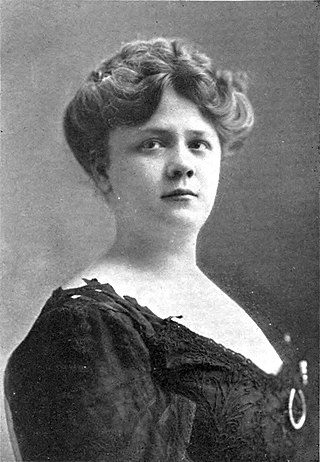
Emma Carus was an American contralto singer from New York City who was in the cast of the original Ziegfeld Follies in 1907.

Phyllis McKee Rankin was a Broadway actress and singer from the 1880s to the 1920s.
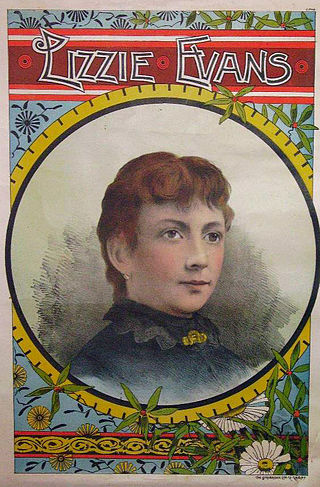
Lizzie Evans was an entertainer in vaudeville and musical theatre in New York City and Chicago, Illinois, from the 1880s into the 20th century. A New York Times article described her as "a bright little person of the Lotta Crabtree physique and school, but with less naturalness and more nasal twang".
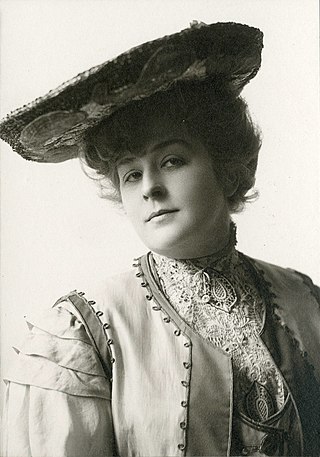
Amelia Swilley Bingham was an American actress from Hicksville, Ohio. Her Broadway career extended from 1896 until 1926.
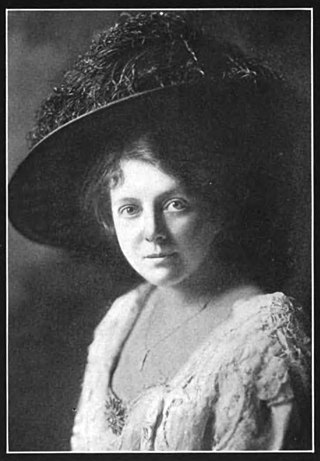
Blanche Lillian Deyo was an American dancer, actress, and singer who performed in multiple theatrical venues -- Broadway, vaudeville, burlesque, ballet, and international variety theaters—throughout the late nineteenth and early twentieth centuries.
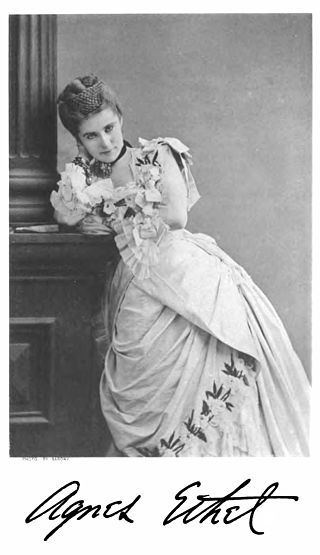
Agnes Ethel was a Broadway actress of the late 19th century. She performed in New York City, the city of her birth, from 1868 to 1871. Her married name was Agnes Ethel Tracy. She was especially talented in acting emotional roles.

The Manhattan Theatre was located at 102 West 33rd Street in Midtown Manhattan, New York City, directly across from Greeley Square at Sixth Avenue and 33rd Street. The 1,100-seat theatre opened in 1875 as the Eagle Theatre, and was renamed the Standard Theatre in 1878. All but destroyed by a fire in 1883, it was rebuilt in a more modern style and re-opened in December 1884. In 1898, the Standard was refurbished by architect Howard Constable and renamed the Manhattan Theatre. The theatre was demolished in 1909 for the construction of a flagship Gimbels department store, now the Manhattan Mall.

Isabelle Urquhart, also known as Belle Urquhart, was an American contralto and actress, noted for her performances in comic opera and musical comedy.
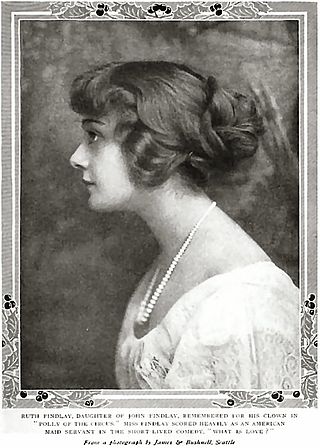
Ruth Findlay was an American stage actress active over the early decades of the 20th century.
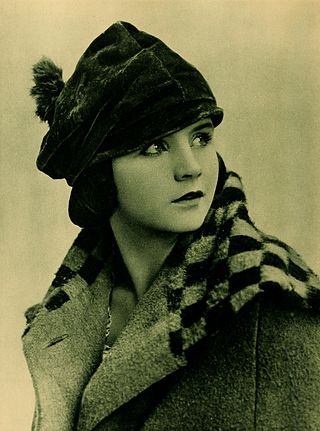
Mary Hay Caldwell was an American dancer, musical comedy and silent screen actress, playwright, and former Ziegfeld girl.

Mrs. Wiggs of the Cabbage Patch is a 1901 novel by American author Alice Hegan Rice, about a southern family humorously coping with poverty. It was highly popular on its release, and has been adapted to film several times. The early editions of the book carry the author's birth name, Alice Caldwell Hegan.

Laura Joyce Bell was an English-American actress and contralto singer mostly associated with Edwardian musical comedy and light opera.

Vera Michelena was an American actress, contralto prima donna and dancer who appeared in light opera, musical comedy, vaudeville and silent film. She was perhaps best remembered for her starring roles in the musicals The Princess Chic, Flo Flo and The Waltz Dream, her rendition of the vampire dance in the musical Take It from Me and as a Ziegfeld Follies performer.

Alberta Gallatin was an American stage and film actress active in the late 19th and early 20th centuries. During her near forty-year career she acted in support of the likes of Elizabeth Crocker Bowers, James O’Neil, Edwin Booth, Joseph Jefferson, Thomas W. Keene, Richard Mansfield, Sir Johnston Forbes-Robertson, Minnie Maddern Fiske, Otis Skinner, Maurice Barrymore, Joseph Adler, E. H. Sothern and James K. Hackett. Gallatin was perhaps best remembered by theatergoers for her varied classical roles, as Mrs. Alving in Henrik Ibsen's domestic tragedy Ghosts and the central character in the Franz Grillparzer tragedy Sappho. Counted among her few film roles was the part of Mrs. MacCrea in the 1914 silent film The Christian, an early 8-reel production based on the novel by Hall Caine.
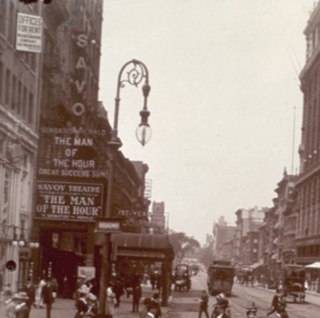
The Savoy Theatre was a Broadway theatre at 112 West 34th Street in Midtown Manhattan, New York City. It opened in 1900. It converted to a cinema around 1910, until it was closed in early 1952 and then demolished.

Mrs. Wiggs of the Cabbage Patch, is an 1903 comedy by American author Anne Crawford Flexner. It was based on two books by Alice Hegan Rice, Mrs. Wiggs of the Cabbage Patch (1901) and Lovey Mary (1903). It has three acts and two settings, all within the "Cabbage Patch", an impoverished neighborhood on the fringes of Louisville, Kentucky. The character-driven play covers three weeks time and has multiple storylines, including an ill-starred mail-order marriage, two refugees from an orphanage, the return of a long-lost husband, and a handful of young romances.